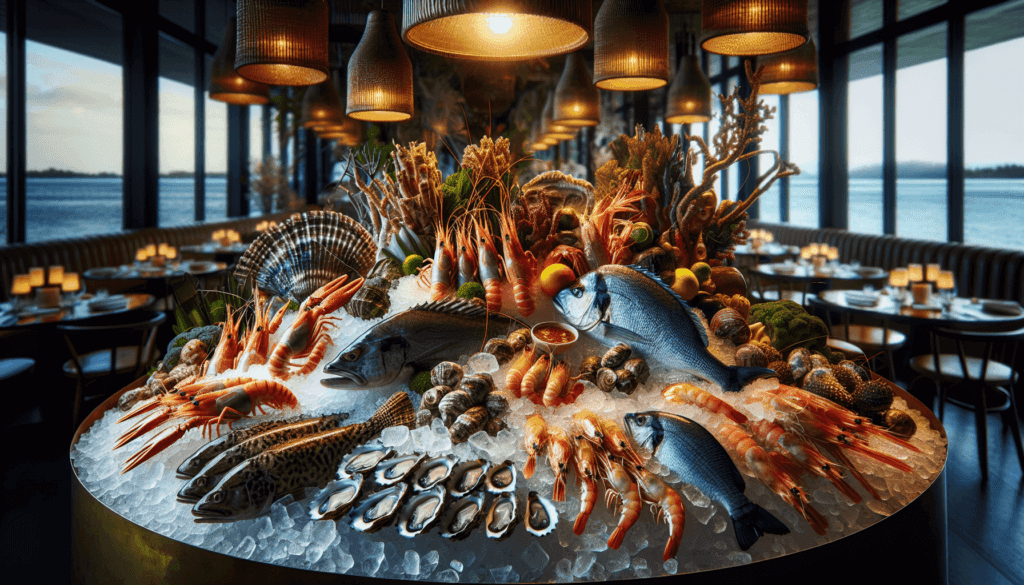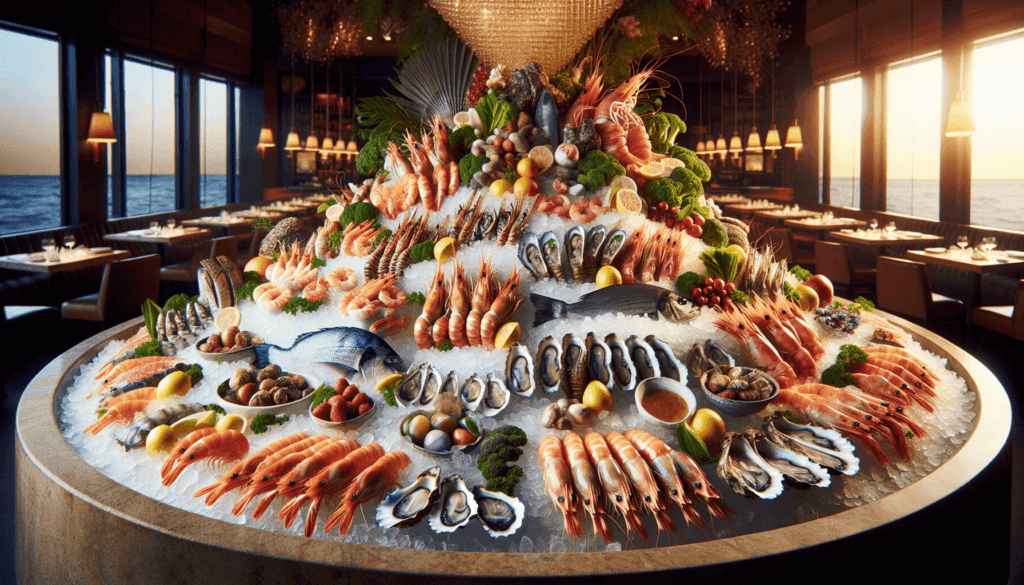The Freshest Seafood Restaurants: Have you ever wondered where to find the freshest seafood in your neck of the woods? Picture this: you’re sitting at a cozy restaurant, the smell of briny ocean air blending with hints of garlic and butter, and the taste of fresh catch that tantalizes your taste buds with every bite. The experience of indulging in a dish where the seafood is phenomenally fresh is unparalleled. Whether you’re a fan of succulent shrimp, buttery scallops, or the tried-and-true fish and chips, knowing where to savor these delicacies locally is akin to having a treasure map of culinary experiences.

Table of Contents
Understanding What Makes Seafood Fresh
One question you might have is, how do you really know if seafood is fresh? The journey of freshness begins long before a dish is served to you. Fresh seafood should have a clean smell, not overly fishy, but more like the sea breeze on a cool morning. It should have firm, translucent flesh and eyes that are clear and plump in the case of whole fish. When you come across shellfish, look for tightly closed shells; this is a sure sign they’re alive and fresh. This isn’t just an overblown way to scrutinize your meal—it’s a vital part of enjoying your seafood to the fullest.
Historical Background: The Evolution of Seafood Dining
Seafood consumption’s allure dates back centuries, with its origins rooted in various cultures and coastal regions. Historically, civilizations settled near the water due to easy access to seafood, which was a crucial source of protein. In medieval England, fish Fridays and the practice of consuming eel pies were institutional—an early legacy of what’s become a thriving global appreciation for seafood. Moving into modern times, seafood has morphed from necessity to luxury, taking center stage on gourmet plates around the world.
From the Ocean to Your Plate: The Journey
Before your seafood arrives at your table, it takes a journey from the ocean to your plate which often involves quick, efficient processing methods to ensure ultimate freshness. Many top restaurants opt for local sourcing to minimize transport time and preserve quality. The whole process is rooted in timing and temperature control—harvested seafood is swiftly chilled and sometimes vacuum-sealed to keep its peak flavor and texture until it’s finally cooked up for your meal.
Discover the Freshest Seafood
Finding the freshest seafood restaurant near you can be an exciting quest. The following are attributes and strategies to guide your culinary adventure:
Local Sourcing and Sustainability
Local sourcing is a critical factor in promoting freshness. Restaurants that commit to purchasing from local fisheries offer seafood that’s directly from nearby waters, cutting down the time from sea to plate significantly. Take a moment to chat with your server or the chef about their sourcing practices. You may find that sustainability is another component that speaks to the quality of the restaurant’s offerings, showcasing a commitment not just to taste, but to protecting marine ecosystems.
Seasonal Menus and Daily Specials
One sign of a top-notch seafood restaurant is a menu that reflects the seasons and daily catch variations. Seafood is at its peak when it’s in season; not only is it more abundant, but it also tends to be more flavorful. Pay attention to daily specials or market dishes, which tend to highlight what’s freshest that day.
Chef’s Expertise and Culinary Techniques
The skill of the chef and their familiarity with various culinary techniques can play a pivotal role in showcasing the true potential of fresh seafood. Whether it’s a classic preparation like poaching or grilling, or more innovative methods like sous-vide cooking, a chef’s expertise can elevate the seafood dining experience.
Types of Seafood to Try
Shellfish
Shellfish like oysters, clams, and mussels are celebrated for their rich, savory flavors—perfect for warming soups or delightful platters paired with tangy mignonette sauce. Each variety boasts its own unique taste and texture. Shelf life can be short, but the joy of freshly shucked shellfish, juicy and slightly briny, makes the brief window entirely worthwhile.
Finfish
A category that encompasses species like salmon, bass, and mackerel, finfish offer versatility with endless culinary applications. Pan-seared, sushi-style, or grilled with a touch of lemon, fresh fish is the quintessential seafood adventure. Freshness here is often evident in the flavor and flakiness, making it a perennial favorite.
Crustaceans
Lobsters and crabs hold a special place in the seafood lover’s heart. A classic lobster bake, replete with drawn butter and corn, or a steamy bowl of crab bisque, are experiences that scream indulgence. The sweetest meat resides in these fan-favorites, especially when you’re assured of their freshness.
Cephalopods
Squid or octopus, when cooked right, are a textural marvel. Grilled, fried, or simmered, these cephalopods, often on the menus of trendsetting eateries, can transform into tender morsels or crispy, delightful rings that pack a punch in every bite.

Top Local Picks to Consider
The Crabby Catch
A beloved institution known for its casual atmosphere and easygoing charm, The Crabby Catch brings local seafood bounty to life. People rave about their spicy shrimp boils and clam chowder, which comes steaming and loaded with tender clams and just the right amount of potato.
Ocean’s Bounty
For a fine dining twist, Ocean’s Bounty is a true delight, combining elegance and fresh fare with beautifully plated dishes. Their lobster bisque is a creamy homage to succulent shellfish, while the smoked salmon soufflé is a showstopper indulging those who favor lighter fare.
Fisherman’s Wharf
A traditional setup, Fisherman’s Wharf is none other than a direct pass to flavors directly from the docks. Here, the fish tacos, wrapped in handmade tortillas and laden with crunchy pickled slaw, are reason enough to mark this spot on your culinary map.
Highlighting Visuals and Enhancing Comprehension
Using Infographics
Consider using infographics to easily understand sourcing processes or popular seafood preparation methods. This visual representation aids in learning, conveying information with clarity and efficiency compared to text alone.
Short Videos for Cooking Techniques
Short videos, easily accessible on platforms like YouTube, demonstrate preparation techniques and recipes efficiently. Such resources provide an opportunity to appreciate the skill involved in achieving perfectly cooked seafood, making these dishes not only accessible but replicable at home.
Crafting the Perfect Seafood Experience: Case Studies
Small-Town Marvel
One community’s vibrant local fish market revitalized with a now-busy drinkery, pedaling everything from dynamite scallop rolls to brilliantly seared tuna. Community bonds and flavorful plates fuse local ethos with culinary expertise.
Waterfront Elegance
In the heart of a bustling city sits a lovely waterfront bistro, offering an idyllic view of the sunset reflecting on the water just as compelling as their citrus zest crab cakes. An exercise in enjoying life’s simple beauties.
Overcoming Common Seafood Dining Challenges
Addressing Dietary Preferences
Various diets can make seafood dining challenging. Fortunately, many establishments cater to pescatarians and vegetarians alike. Whether it’s substituting grilled mushrooms in a classic seafood dish or ensuring soups are prepared with a vegetarian base, dining diversity is achievable.
Navigating Allergies
Seafood allergies are no small concern; sensitivity to specific shellfish or fish requires due diligence. Check menus and consult staff regarding preparation practices to ensure there’s no cross-contamination for a worry-free dining experience.
Dealing with Picky Eaters
Introducing seafood to skeptical taste buds should not be a culinary conundrum. Opt for familiar flavors like crispy calamari or simple grilled fish, often universally appealing and far from intimidating.
Sustainability’s Role in Seafood Dining
Incorporating sustainability into your seafood dining habits assures beneficial health and environmental impacts. It underscores the importance of fishing practices that maintain the delicate balance within marine ecosystems, encouraging responsible consumption and ensuring what’s on our plate doesn’t compromise tomorrow’s oceans.
The Future of Seafood Dining
Technological advancements are revolutionizing how seafood is sourced and served. Expect the rise of digital menus highlighting sustainability scores alongside traditional tags like price and calories. As society becomes more health-conscious, virtual reality tours showcasing sourcing or preparation might better inform and inspire diners.
Conclusion: Your Guide to a Delicious Experience
Savoring fresh seafood is not just about satisfying hunger, but about engaging in a journey brimming with flavors and stories that celebrate traditions and environments. From understanding sourcing practices and choosing the perfect restaurant to exploring types of seafood and delving into future trends, you hold the map to remarkable seafood dining experiences. Now, armed with this guide, what will be your next seafood stop?
Additional Resources
For more insight into making the most of local seafood, consider reading “Beyond Sushi: A Beginner’s Guide to Global Seafood” or dive into “Sustainably Savory: An Adventure into Ethical Eating.” Both of these guides offer deeper understanding for those aiming to expand their culinary horizons and embrace fresh, responsible seafood dining like never before.
Hot🐳 The Moorings Guesthouse & Seafood Restaurant, Portmagee, Ireland
